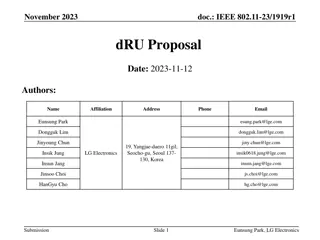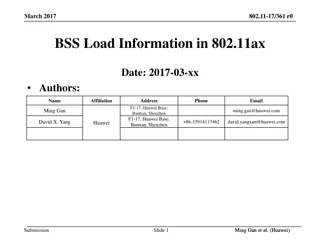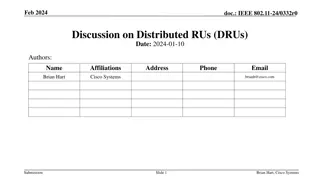Bitmap Indication for OFDMA Transmission
Dec. 2020 introduces a preamble puncture bitmap indication for 20/40 MHz OFDMA transmission, proposing to use '1111' when no puncturing is applied. The straw poll suggests adding this indication to the TGbe SFD. The submission highlights the specific bit values for punctured 20 MHz channels within a
2 views • 5 slides
IEEE 802.11-20/0985r5 RU Allocation Subfield Design in EHT-SIG
The document discusses the design of subfields in EHT-SIG for RU allocation in IEEE 802.11be, focusing on reducing overhead by considering supported large-size MRU combinations. It addresses concerns on entries overhead in the RU allocation subfield table and the clarity of support for specific MRU
3 views • 24 slides
Coordinated AP Time/Frequency Sharing in IEEE 802.11be
The document discusses Coordinated AP (CAP) Time/Frequency Sharing in Transmit Opportunity in IEEE 802.11be, focusing on Frequency and Time resource sharing between multiple APs in close proximity. It introduces concepts like CAP OFDMA and CAP TDMA, outlining the benefits in terms of latency improve
0 views • 15 slides
IEEE 802.11-20/1238r5 August 2020 Preamble Design Open Issues
In these slides, designs for U-SIG content & overflow and EHT-SIG design are proposed. The focus is on punctured channel indication design with the aim of conveying puncturing patterns efficiently while keeping signaling overhead low. The proposal includes a 6-bit field for puncturing information, a
1 views • 41 slides
Use Case for Distributed Resource Units in Downlink Scenarios
The document explores the concept of distributed Resource Units (dRU) in downlink scenarios in IEEE 802.11 standards like 802.11ax and 802.11be. It discusses the benefits and potential advantages of using dRU in downlink transmissions, focusing on how it can effectively distribute tones across the s
3 views • 13 slides
Considerations on Coordinated OFDMA Operation in IEEE 802.11
The document discusses the Coordinated OFDMA (C-OFDMA) operation as a part of Multi-AP coordination schemes within the IEEE 802.11 standard. It covers resource allocation options, topology considerations, resource allocation methods, capability announcement procedures, and negotiation processes betw
0 views • 15 slides
IEEE 802.11-20/0095 PHY-Related Agreements for SST
IEEE 802.11-20/0095 outlines agreements related to PHY aspects impacting the definition of Spatial Stream Tapping (SST) in 802.11 standards. The focus is on enabling 80 MHz operating stations to participate in 160 MHz OFDMA, including in non-primary 80 MHz scenarios. Various considerations and scena
1 views • 11 slides
Proposed 80 MHz EHT LPI PPDU Format for IEEE 802.11-20/1347r1
The document presents the proposed LPI PPDU format for IEEE 802.11-20/1347r1, focusing on enhancing the robustness of the preamble and payload in non-OFDMA frames. The format includes repetitions of U-SIG and E-SIG symbols, optimizing DCM gain for improved performance. Simulation results show advant
0 views • 12 slides
Coordinated AP Time/Frequency Sharing in IEEE 802.11be
The document discusses the concept of Coordinated AP (CAP) Time/Frequency Sharing within a Transmit Opportunity (TXOP) in the IEEE 802.11be standard. It explains the procedures of Frequency and Time resource sharing, highlighting the benefits such as latency improvement and throughput fairness. Deta
0 views • 16 slides
IEEE 802.11-23/1919r1dRU Proposal for Range Extension and RvR Enhancement
This proposal introduces dRU support for 11bn to overcome PSD limitations, enabling range extension and RvR enhancement. It reviews previous dRU contributions in UHR SG and details new proposals including distributed tones across channels, dRU tone plans in different MHz channels, and pilot designs
0 views • 22 slides
Efficient Preamble Puncturing Support for IEEE 802.11 EHT Wide Bandwidth Transmission
The IEEE 802.11-20/0895r0 document addresses the introduction, issues, motivation, and support for preamble puncturing in EHT transmissions. It focuses on optimizing resource allocation while facilitating flexible preamble puncturing for OFDMA transmission in wide bandwidth scenarios, such as managi
0 views • 14 slides
Enhancing Wireless Spectrum Efficiency with Distributed-Tone Resource Units in IEEE 802.11
In the document "Jan 2023.doc: IEEE 802.11-23/0037r0," the focus is on leveraging Distributed-Tone Resource Units (dRU) to overcome Power Spectral Density (PSD) limitations in wireless communication. By distributing tones over a wide bandwidth, dRU allows for higher transmit power, enabling enhanced
0 views • 9 slides
Enhancing Support for Wider Bandwidth OFDMA in IEEE 802.11 Networks
The document discusses the implementation of Selective Spatial Transmission (SST) and Dynamic Subband Operation (DSO) to enable wider bandwidth OFDMA in IEEE 802.11be and 802.11bn standards. It covers enhancements for 80MHz, 160MHz, and 320MHz EHT DL and UL OFDMA transmissions, emphasizing the benef
0 views • 18 slides
Enhancing BSS Load Management in 802.11ax Networks
Proposed changes to address load balancing issues in dense 802.11ax scenarios by introducing a new information element for BSS Load. The new element considers OFDMA utilization, UL/DL MU-MIMO, and allows for future extensions to ensure efficient AP selection by unassociated STAs. Enhancements aim to
0 views • 14 slides
Wireless Broadband Technologies Overview
Delve into the world of wireless broadband technologies with a focus on Mobile WiMAX based on IEEE 802.16e. Explore concepts like OFDM and OFDMA, subchannelization schemes, OBBP vs. MOBBP, simulation results, and more. Discover the implementation of the Orientation-Based Burst Packing algorithm and
0 views • 66 slides
Discussion on Multi-AP Coordination Architecture in IEEE 802.11-23
In this document, Xiaofei Wang from InterDigital Communication Inc. discusses the architecture required for multi-AP operations, seamless roaming support, and general MLD operation support in the context of IEEE 802.11-23 standards. The focus is on coordinating various operations across multiple APs
0 views • 9 slides
Multi-AP Coordination for Low Latency Traffic Transmission
The document discusses the integration of multi-access point (AP) coordination to enhance the transmission of low-latency traffic in wireless networks. It addresses the challenges and introduces modes of operation capable of reducing latency and improving reliability for low-latency (LL) traffic tra
0 views • 9 slides
Simulation Results for Coordinated OFDMA in Multi-AP Operation
Multi-AP operation, specifically Coordinated OFDMA, is evaluated through system-level simulation results in a two-BSS scenario. The performance metrics include burst throughput and delay in a burst traffic model. Transmission procedure involves two APs sharing 160MHz bandwidth. The study aims to sho
0 views • 9 slides
IEEE 802.11-16/0592r0: Follow-up on Unused UL OFDMA RUs
In May 2016, a presentation by Stéphane Baron and team from Canon addressed the issue of unused Random Units (RUs) in UL OFDMA transmission in IEEE 802.11 standards. The presentation covers the consequences, simulation results showing significant unused RUs, and a proposed solution of random RUs in
0 views • 8 slides
IEEE 802.11-23/1953r0 Two-Dimensional Resource Allocation (UL OFDMA)
Introducing a novel approach for uplink transmissions in UHR to achieve low-latency communication. The document discusses UL OFDMA in detail, emphasizing the use of a two-dimensional resource unit. Key topics covered include UL MU operation, UL OFDMA-based random access, and allocation of RUs for ra
0 views • 16 slides
Discussion on Distributed RUs (DRUs) in IEEE 802.11-24/0332r0
The document discusses Distributed RUs (DRUs) as a solution to work around 6 GHz regulations limiting transmit PSD per MHz. DRU energizes a few subcarriers per MHz to improve link budget by 11 dB at the cost of data rate scaling. It also examines the problem of throughput degradation in DRU with ins
0 views • 9 slides
Understanding OFDMA Frame Structures in 4G and 5G Networks
Explore the distinct OFDMA frame structures in 4G and 5G networks, including frequency and time domain elements, resource allocation details, subcarrier spacing, RB allocation, numerology, and scalable subcarrier spacing. Learn about PDSCH resource allocation types, RBG configurations, and more thro
0 views • 15 slides





















